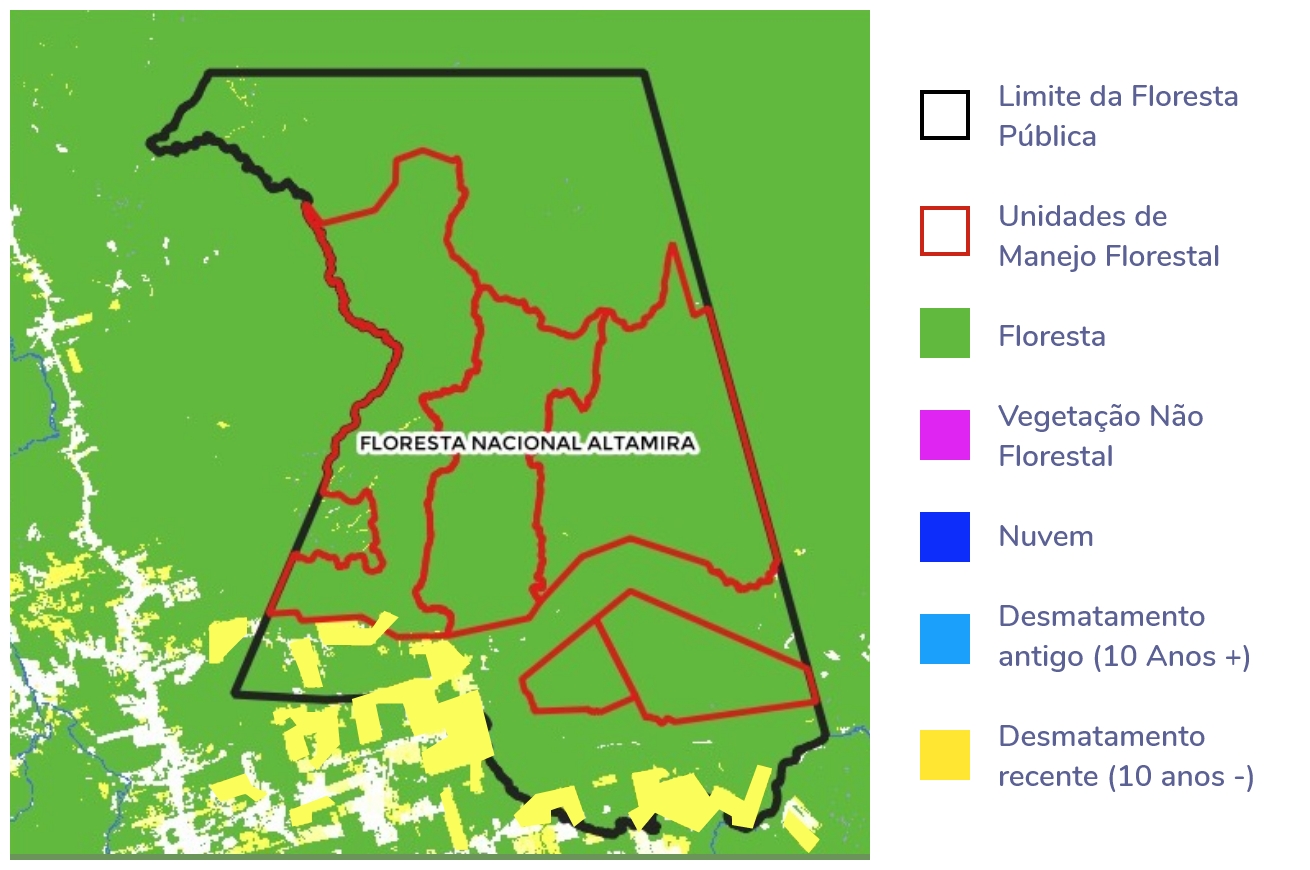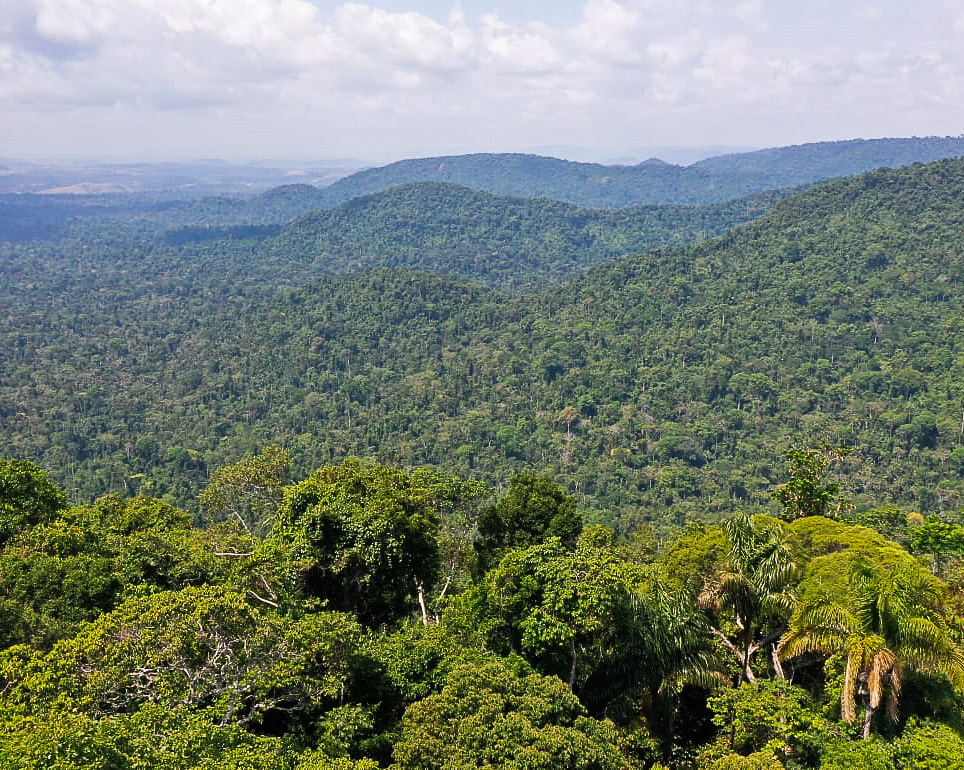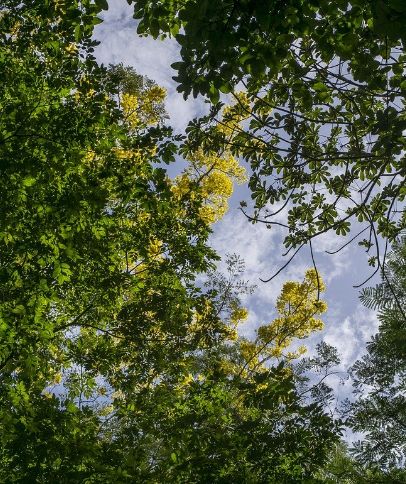Map of the Potential for CO2
Credits in Forest Concessions
Click on the areas of National Forests (Flonas) or State Forests (FES) to obtain greater details
Available layers
Potential for carbon credits
{{aberta.nome}}
Potential for REDD+ CO2 credits in forest concessions
Potential for CO2 credits through reforestation in forest concessions
boundary
vegetation
(over 10 years old)
(less than
10 years old)
Potential for carbon credits
Scenario with less pressure from deforestation: {{virgula(aberta.cenario_conservador.creditos_redd,0)}} credits per year Scenario with greater pressure from deforestation: {{virgula(aberta.cenario_pressao.creditos_redd,0)}} credits per yearPotential revenue of the area available for concession
Scenario with less pressure from deforestation: {{virgula(aberta.cenario_conservador.aporte_financeiro,0)}} US$ per year Scenario with greater pressure from deforestation: {{virgula(aberta.cenario_pressao.aporte_financeiro,0)}} US$ per yearDATA SOURCE: Serviço Florestal Brasileiro (2021); Instituto Chico Mendes de Conservação da Biodiversidade (2021); Instituto Nacional de Pesquisas Espaciais (2021); ORNL DAAC (2020). Accessed in 2021.
Carbon Credits in
Forest Concessions:
How Much Can Brazil
Gain by Keeping
the Forest Standing?
Explore the potential calculated by Instituto Escolhas for generating and trading carbon credits produced by REDD + (Reducing Emissions from Deforestation and forest Degradation) and reforestation projects in Brazilian forest concessions.

Although Brazil has the largest tropical forest in the world, the country is still lagging behind others like Colombia and Peru in terms of voluntary generation of credits based on forest carbon offsets, with 20 certified REDD+ projects underway and only two of them in public forests (Verra, 2021). The generation of carbon credits in forest concessions can be a pathway to change this scenario.

Largely due to restrictions in the legal framework, Brazilian forest concessions are not yet implemented to their full potential, with few areas currently under concession and operations focused exclusively on sustainable timber management.
To boost forest concessions and diversify the sustainable activities allowed, Instituto Escolhas supported the elaboration of Bill No. 5.518/2020, which – among other innovations – allows the generation of credits resulting from avoided carbon emissions due to the conservation of natural forests, the so-called REDD+ credits. Under the current legislation, only credits from reforestation projects can be produced in forest concessions.
How much could forest concessions gain with the generation and trade of carbon credits? Check out the numbers below.


Main results
Potential for REDD+ carbon credits in the Amazon:
(37 forest concession areas)

REDD+ carbon credits/year
Twice the volume of REDD+ credits that Brazil currently offers

per credit
year

million/
year
* Average price of carbon credits from forest and land use projects in 2019, according to the State of the Voluntary Carbon Markets 2020 report.
** Variation according to the two scenarios built, with greater or less pressure from future deforestation.
*** US$ 1 = R$ 5,22 (Source: Brazilian Central Bank, 09/14/2021).
Potential for carbon credits through
reforestation in the Atlantic Forest:
(5 forest concession areas)

Carbon credits in reforestation projects/year
3 times the volume of credits through reforestation that Brazil currently offers

per credit
year

million/
year
Method
The study estimated the potential for generating carbon credits in public forest areas that are currently under concession or available for concession according to federal and state agencies in charge of forest management.
Data
Which forests have the greatest potential?
Federal
 Please rotate your mobile device to see the full graph
Please rotate your mobile device to see the full graph
State
 Please rotate your mobile device to see the full graph
Please rotate your mobile device to see the full graph
Do forest concessions
help curb deforestation?
Data from the study also showed that the deforestation rates observed within the Forest Management Units (UMF in Portuguese) under concession are inferior to those observed in other areas of the public forests. On the other hand, when deforestation increases in these public forests, it also threatens areas that are under concession. The sustainable forest management activities developed in forest concessions are complementary to command-and-control actions conducted by the State. Observe the case of the National Forest (Flona) of Altamira on the graph aside.


In areas where deforestation is verifiably reduced, the concessionaire is providing an environmental service that can be rewarded through the sale of carbon credits.
Flona of Jacundá (Rondônia):
Carbon credits can increase the revenue from timber management in forest concessions by 43%.
In the case of the forest concession operated by the company Madeflona in the Flona of Jacundá, the study estimated a potential of 2,57 REDD+ credits per hectare, which could amount to US$ 970.380/year when you consider the entire area under concession. On the other hand, the revenue from timber management in the Annual Production Units (UPA in Portuguese) explored in 2020 was estimated at approximately US$ 2.2 million. The potential revenue from the sale of carbon credits in this case represents 43% of the revenue from timber management.
Payments for environmental services can be strategic to complement the economic returns from sustainable timber management, improving the operation´s cash flow.


Forest concessions
What are they, and how do they work?
Forest concessions make it possible to grant areas of public forest to the private sector, encouraging the development of economic activities that generate income by keeping the forest standing.
This instrument was instituted in 2006 by the Public Forest Management Law (Lei de Gestão de Florestas Públicas – LGFP), which also created the Brazilian Forest Service (Serviço Florestal Brasileiro – SFB) to manage the forest concessions at the federal level.
The SFB is responsible for selecting the areas that can be awarded, organizing the bidding processes and monitoring contracts, with a duration of up to 40 years. Some states, mainly in the Amazon, also implement concession policies in state public forests, managed by bodies such as IDEFLOR-Bio in the case of Pará.
According to the LGFP, the following areas CANNOT be used for concessions:
-
Conservation Units (UCs) of integral protection;
-
UCs for sustainable use of the following categories: Sustainable Development Reserves (RDS); Extractive Reserves (RESEX); Fauna Reserves and Areas of Relevant Ecological Interest (ARIE);
-
Indigenous Lands;
-
Areas occupied by local communities or dedicated exclusively to community management;
-
Areas of interest for the creation of UCs;
-
UCs that lack a Conservation Unit Management Plan in force.
Once all these territories are excluded, the SFB identified that:

Among the
229.256.439
hectares of federal public
forests in Brazil,
5.349.929
hectares are available
for concession in 2022.
Currently, slightly over
1.000.000
hectares are under federal concession in Brazil
– all of them in the Amazon (PAOF, 2022).

Carbon markets
What are they, and how do they work?The retention and capture by forests of carbon dioxide (CO2) from the atmosphere is an essential service that contributes to climate regulation and climate change mitigation.
Among all the environmental services that forests provide, so far this is the only one with consolidated economic valuation mechanisms and markets. In other words, those responsible for protecting and managing the area can be rewarded for offering this environmental service.


Discussions about the regulation of carbon markets are part of the Conferences of the Parties (COPs) of the United Nations Framework Convention on Climate Change since the signing of the Kyoto Protocol, in 1997.

Since then, certification methodologies and carbon credit transaction mechanisms have evolved, but the political consensus necessary to create a global market has not yet been reached.
The possible regulation of Article 6 of the Paris Agreement at COP 26, which will take place in October 2021, in Glasgow, UK, raises expectations that progress on this agenda will be made soon.
While a regulated market is not established as a global mechanism, linked to the Nationally Determined Contributions, for mitigating and reducing greenhouse gas (GHG) emissions, carbon markets regulated at the regional (such as the European Union), national (such as China), or subnational levels (like that of California) are being consolidated.

In addition, a voluntary market has also emerged, in which companies, individuals, social organizations, and governments can voluntarily generate or buy carbon credits through projects that remove, prevent, or reduce GHG emissions into the atmosphere.
Types of carbon credits
in the voluntary market

Credits generated
through reforestation
projects
The planting of new trees generates credits through CO2 removal, where atmospheric carbon dioxide is captured through photosynthesis and stored in forest biomass.

Credits generated
through avoided
deforestation
projects (REDD+)
The conservation of natural forests generates credits through CO2 reduction, considering it remains stored in forest biomass rather than being unleashed into the atmosphere with deforestation.
How to trade credits
The Verified Carbon Standard (VCS) is the main certification standard for the voluntary carbon credit market, which registers and monitors projects that reduce or remove GHG emissions across different sectors. The purpose of certification is to trace credits from their origin to their expiration, guaranteeing the credit’s environmental integrity by ensuring that it is linked to a project that effectively reduced emissions.
When a registered project proves that it has been able to reduce or remove an amount equivalent to a metric ton of CO2 from the atmosphere, it attains the right to issue a carbon credit.
These credits are purchased by institutions that wish to mitigate their GHG emissions, a practice that is becoming increasingly widespread. A growing number of companies are making commitments to achieve carbon neutrality – the so-called Net Zero – by buying credits to compensate the emissions generated by their operations (Viri, 2021).

1. Trees not only remove CO2 from the atmosphere through photosynthesis, but also store CO2 within their biomass, above and below ground.
2. Forest conservation or reforestation projects can generate 1 carbon credit for every metric ton of CO2 that is removed or kept from being released into the atmosphere.
3. Businesses, organizations and even countries can buy these credits to compensate their emissions.
Technical specifications
General CoordinationTeresa Rossi and Jaqueline Ferreira
(Instituto Escolhas)
Technical ExecutionRogério Ribeiro Marinho and Igor Oliveira Ribeiro
Design and developmentFábrica de Ideias Brasileiras
Text editingBruna Cenço, Jaqueline Ferreira and Teresa Rossi (Instituto Escolhas)
How to citeInstituto Escolhas. Carbon Credits in Forest Concessions: How Much Can Brazil Gain by Keeping the Forest Standing? São Paulo, 2021.
Contact: comunicacao@escolhas.org
www.escolhas.org
Product license CC BY-SA 4.0
Glossary
Annual Forest Grant Plan (Plano Anual de Outorga Florestal – PAOF): document elaborated by the Brazilian Forestry Service that lists all areas available for forest concessions and the criteria used to select them.
Carbon credits from REDD+ projects: the conservation of natural forests generates credits by avoiding emissions associated to deforestation and maintaining carbon stored in forest biomass, thus reducing the amount in the atmosphere.
Carbon credits from reforestation projects: the planting of new trees generates credits through carbon removal, where atmospheric carbon dioxide is captured through photosynthesis and stored in forest biomass.
Environmental services: services provided by nature that contribute directly or indirectly to human well-being, such as erosion and rain cycle regulation or heat and flood mitigation.
Forest concessions: areas of public forests that are temporarily granted to the private sector, through a bidding process, in order to develop economic activities related to sustainable forest management.
Forestation/Reforestation: forestation is generally associated to the intensive planting of commercial species, whereas reforestation consists in the planting of native species aiming to restore the original ecosystem.
Greenhouse Gases (GHG): atmospheric gases such as CO2, CH4 e N2O that absorb part of the infrared radiation emitted by the Sun and reflected on Earth’s surface, keeping this radiation (heat) from escaping into space.
Offset: the compensation mechanism that allows the conversion of a verifiable GHG emission reduction into a credit that grants another actor (the buyer) the right to emit GHG.
REDD+: Reducing Emissions from Deforestation and forest Degradation, plus (+) the sustainable management of forests, and the conservation and enhancement of forest carbon stocks.
Verified Carbon Standard (VCS): the main certification standard for the global voluntary carbon credit market.

References
FOREST TRENDS. State of the Voluntary Carbon Markets 2020. Available at: https://www.forest-trends.org/publications/state-of-the-voluntary-carbon-markets-2020-2. Accessed on: 8 May 2021.
INSTITUTO NACIONAL DE PESQUISAS ESPACIAIS. Coordenação Geral de Observação da Terra. [National Institute for Space Research. General Coordination of Earth Observation.] Programa de Monitoramento da Amazônia e demais Biomas. Desmatamento – Amazônia Legal. [“Monitoring Program for Amazon and other Biomes”.] Available at: http://terrabrasilis.dpi.inpe.br/downloads. Accessed on: 5 April 2021.
PROJETO MAPBIOMAS. Coleção 5 da Série Anual de Mapas de Cobertura e Uso de Solo do Brasil. [“Collection 5 of the Annual Series of Land Cover and Use in Brazil”.] Available at: https://mapbiomas.org/download. Accessed on: 25 May 2021.
SERVIÇO FLORESTAL BRASILEIRO [Brazilian Forestry Service]. Plano Anual de Outorga Florestal 2021. [“Annual Forest Grant Plan 2021”.] Available at: https://www.florestal.gov.br/documentos/publicacoes/4567-paof-2021-revisao-final-15julho20. Accessed on: 2 April 2021.
SERVIÇO FLORESTAL BRASILEIRO [Brazilian Forestry Service]. Plano Anual de Outorga Florestal 2022. [“Annual Forest Grant Plan 2022”.] Available at: https://www.gov.br/agricultura/pt-br/assuntos/noticias/consulta-publica-colhe-sugestoes-sobre-concessoes-florestais-para-manejo-em-2022/Paof2022versoparaconsultapblica31mai2021.pdf. Accessed on: 15 May 2021.
VERRA. Verra Registry. List of registered Verified Carbon Standard (VCS) projects. Available at: https://registry.verra.org/app/search/VCS/Registered. Accessed on: 10 May 2021.
VIRI, Natalia. O que você precisa saber para começar a entender o mercado de carbono. [“What you need to know to begin understanding the carbon market”.] Capital Reset, 2020. Available at: https://www.capitalreset.com/o-que-voce-precisa-saber-para-comecar-a-entender-o-mercado-de-carbono. Accessed on: 12 April 2021.





